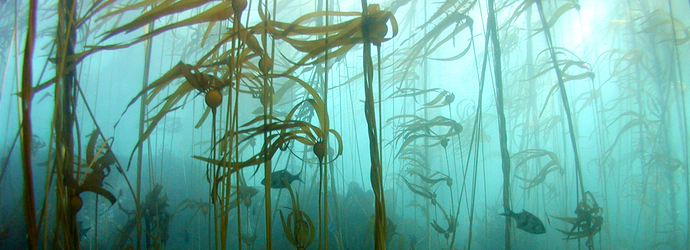It’s time to make room for kelp in the discussion about ocean acidification.
Photo: Oregon Coast Aquarium
Keighley Lane, MAS MBC Candidate ’19
For those of you in the broader ecology community, you may have heard so much about ocean acidification by now that you could recite it in your sleep. Specifically, the process through which the oceans absorb extra carbon in the atmosphere, and how this can tip seawater chemistry towards a more acidic state. Or how this decreased pH threatens to obliterate the beautiful corals of the world. Coral dominates the headlines. But there’s another acidified ecosystem out there deserving of a public platform, one that gets little of the limelight yet conveys equally critical ecosystem services, food security, and coastal protection to its communities– the kelp forests of the Pacific Northwest. This ecosystem is an important piece of the narrative because it is particularly vulnerable.
The coastal Pacific Northwest experiences seasonal upwelling where waters that are naturally low in oxygen and rich in carbon dioxide rise to the surface. These areas also receive lots of freshwater from rain and rivers that carry nitrogen runoff, depleting oxygen with algal bloom die-offs. According to the WA Blue Ribbon Panel on Ocean Acidification, these combined effects mean that kelp forests are likely to see the impacts of ocean acidification on its marine creatures sooner than other regions. Additionally, more than thirty percent of its organisms are calcifiers (organisms that depend on less acidic waters), including shellfish.
The Washington state shellfish industry was one of the first groups to ring the alarm on ocean acidification. Some might call it the $270 million canary in the coalmine. In 2005, one hundred percent of young oysters died at two major hatcheries in Washington State, and the industry has struggled ever since. When research first connected the die-offs to decreased pH, few outside the industry gave it much attention, but it now is the subject of numerous studies and a statewide task force. One motivation being that the industry is a way of life for many families and its collapse could lead working families to disperse. East Coast scallop farmers are worried that they will be hit next and are looking to the west coast for solutions.
Recently, the Seattle Times reported that a team of scientists was “investigating whether growing kelp can reduce carbon-dioxide levels in the inland marine waters of Puget Sound.†The theory is that kelp can “purify†the water column in the short-term, by taking up large amounts of carbon dioxide into their tissues. While this solution doesn’t solve ocean acidification in the long run, the scientists have found evidence that this could be an adaptive strategy for the shellfish industry, at least until the next big kelp die-off. Whatever the case may be, many Americans have a hard time relating to coral reefs they’ve never seen. Let’s adjust our conversations to talk to them about local kelp, and the stories of the American oyster farmer, or the New England scallop farmer, and then, if the connection has been made, the ways in which someone who lives nearby can limit their nutrient runoff or carbon emissions.

